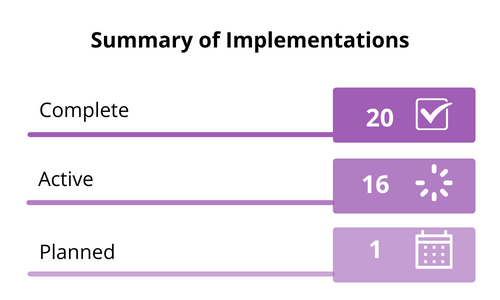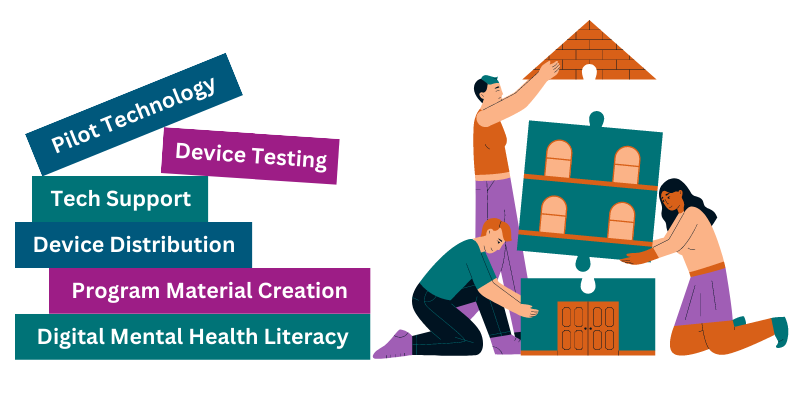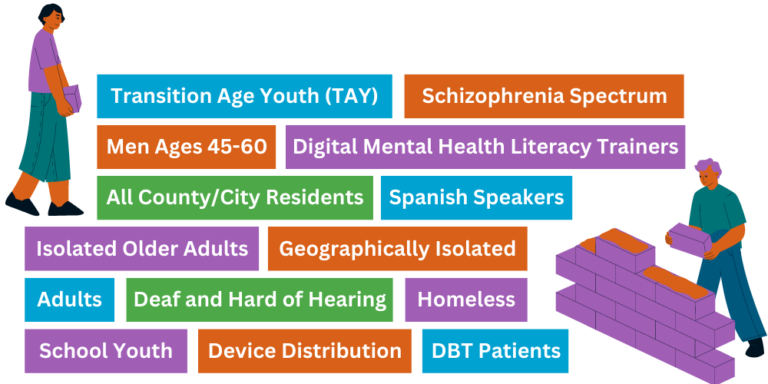Help@Hand Project Dashboard
Join us in celebrating how far the Help@Hands Collaborative has come with innovation projects!
Participant Testimonials
Take a moment and see testimonials from participants on how they benefited from the Help@Hand project. Then learn about what it takes to serve a community with an innovative idea.
Help@Hand Project Timeline

We’re more than halfway through the journey of learning how to increase access to mental health care to those in need. Help@Hand is a $75.2 million dollar innovation project that is funded as a result of Proposition 63 and the Mental Health Services Act (MHSA). This timeline shows funding held by CalMHSA for city/county and collaborative spending on innovation projects to:
• invest in developing local resources
• purchase devices
• acquire technology licenses
• develop the Help@Hand website
• plan technology pilots
• translate Collaborative materials
• cover general project management and evaluation costs
Stars on the timeline (above) represent information such as reports and webinars that explain how funding fulfills the Help@Hand purpose. Click on the years for each report to learn more.
 Blue Stars– Stakeholder Webinars (Events held to inform a program status for stakeholders)
Blue Stars– Stakeholder Webinars (Events held to inform a program status for stakeholders)
 Purple stars – University of California Irvine (UCI) Evaluation Report (An annual evaluation of on Collaborative project progress and stakeholder feedback)
Purple stars – University of California Irvine (UCI) Evaluation Report (An annual evaluation of on Collaborative project progress and stakeholder feedback)
Summary of Implementations
Counties and cities implement or run Help@Hand projects to learn how technology allows people to get access to mental health care. They are also able to discover if it helps. Implementations start with a plan to use technology or a service such as an app or Digital Mental Health Literacy Training (DMHLT). Next, counties and cities work with internal departments, Peers, and vendors such as companies that provide marketing and training to get everyone ready to use the apps. When planning is done, the implementation becomes “Active”. This means that people are getting mental health care by using technology. When the implementation has ended or completed, UCI follows up with a final evaluation. This information can be found in the UCI Annual Evaluation Report.

This image shows the number of implementations that are being “Planned”, those that are “Active”, and those that are “Completed”.
Peer Contributions
One Help@Hand goal is to incorporate Peer input, expertise, knowledge and lived experience at all levels of the project, and to support the use of Innovation apps through Peer outreach and training.
To date, Peers have brought a wealth of knowledge and care that is critical to project success. Their contributions include but are not limited to: device testing, technology support, device distribution, program material creation, Digital Mental Health Literacy Training (DMHLT). Peers are often “boots on the ground”, communicating directly with project participants and community organization members, acting as a bridge between products/services and users. They are as varied as the people they serve and continue to deliver support to those in need.

Servicing Our Community
Counties/Cities in the Help@Hand program approached innovation projects with the idea of addressing mental health care needs for community members. Outreach was conducted to spread the word about Innovation products and services as available options to help people through their daily challenges and exceptional circumstances such as COVID-19. This effort drove participation on pilots and implementation projects using common and unique marketing strategies. Marketing activities included installing product kiosks in clinics, organizing diverse marketing campaigns with flyers, radio ads, community outreach, leveraging social media and building relationships with community partners to spread the word.
The Help@Hand project continues to reach and serve a diverse group of community members: All County/City residents, Schizophrenia Spectrum, Transition Aged Youth (TAY), Deaf and Hard of Hearing, Isolated Older adults, Residents with Eating Disorders, Digital Mental Health Literacy Trainers, School Youth, Men Ages 45 to 60, Adults, Spanish Speakers, Homeless, Geographically Isolated, Dialectical Behavior Therapy (DBT) Patients. To reach such a diverse group of people, counties/cities applied their awareness and understanding of community needs, and a little creativity on sending them the message for the types of mental health options that were available to the community.

*This page was last updated: December 2023
